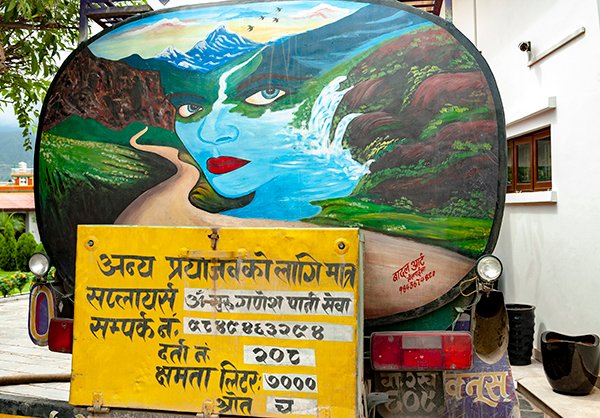The story of Nepali truck art, the artists and its impact on the travellers
While travelling on meandering Nepali highways, you curse the dusty, smoky roads, which are perpetually under repair. You get stuck behind a smoke-belching truck or tanker. The smoke dissipates; the dust settles down to reveal the back of the vehicle, depicting Shiva smoking Ganja or a vibrant countryside, with poetic or purposeful messages in calligraphy. The image elevates your mood and relieves you from boredom in a traffic jam.
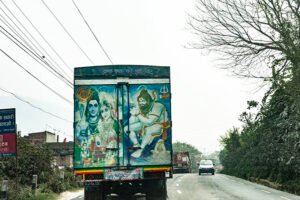
Shiva & Parvati and Shiva smoking Ganja
That, dear traveller, is the power of truck art and verses, which compels you to reflect and adds value to your bumpy, tedious journey. These are not arbitrary paintings or writings. They are painted with a purpose.

The wrathful Bhairava
Conception
Generally, the owner or driver of the truck conceives the design and phrases and commissions the painting. They send the conceived images to the artists. These concepts have multi-dimensional aspects, like socio-cultural, religious, or patriotic. Many of these are about personal experiences, often after separation from the family or a beloved. The images and messages are idealistic yet provide respite.
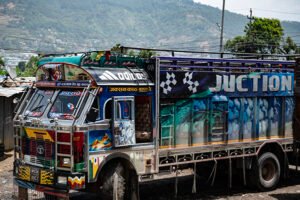
Abstract truck art
To the drivers of long-distance carriers, the trucks are their homes. They take pride in decorating to make these look better than the others. There is hardly space inside the cabins that double up as bedrooms when they rest. The only space to decorate is the exterior where they share their ideals and showcase the best of their world of roads. Their loved vehicles are carriers of cargo, water as well as their artistic beliefs. For this, they reach out to prolific truck painters.

Decorated trucks amidst greasy sludge.
Stickers of the late King Birendra’s family is an all-time favourite
Creation
The truck painters of Nepal are artists in their own rights. They work diligently in or near garages and auto workshops in Sanepa, on Prithvi and Arniko Highways. The working environment is noisy and grimy with greasy sludge all around. Not the ideal ambience for an artist. However, once you look up from the dirty garage grounds, you will find dazzling colours on the trucks that are being painted.

Truck artist Ram Vilas Mahra
Trinetra Art, Thankot
Truck Artist at Thankot
Amid such settings, entrepreneur Ram Vilas Mahra of Trinetra Art (Thankot), busily paints a truck. He is originally from the Parsa Municipality. His artistic mother inspired him in his infancy. Despite wanting to learn more, he could not get admitted to art schools due to a lack of funds and time. His artist guru chanelled Ram Vilas’ talent towards this profession that ensured monthly earnings. He has persisted for 25 years now. Ram earns enough to support his family, children’s education, room rent and staff salaries.
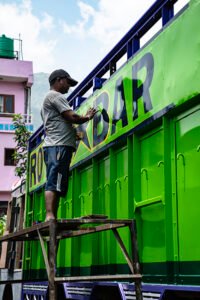
Truck artist Ram Vilas Mahra on scaffolding, while painting
The rates for truck art are commensurate with the amount of customisation, size and make of the vehicle, cost of materials and labour charges. Labour cost is between NPR 20-25,000/- for each truck. Materials like paint, putty, brushes, etc. cost approximately NPR 35-40,000/-. Approximately, NPR 60-70,000/- per truck. Assisted by two helpers, he takes around 7-10 days to complete painting the body of a truck and paints around 2-3 vehicles a month. Orders are less due to inflation. So, many customers opt for flex prints on the trucks instead of hand paintings as these are cheaper and quicker.
Ram Vilas has opened a small shop on the main road to attract attention and build contacts. The Trinetra Art shop operates from 8 A.M. to 5 P.M. and sells stickers, flexes, and signboards that he procures from Bagbazar. The stickers are usually put on mirrors or metal doors of vehicles. These saleable items support his business even when orders decrease.
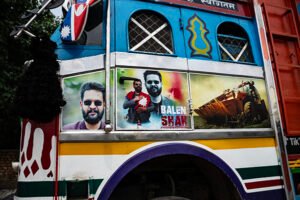
Stickers on truck. Kathmandu Mayor Balen Shah is the current favourite.
Truck Artist at Sanepa
At Sanepa’s New Durga Kali Auto Workshop, Washing & Servicing Centre, young employee Manish Kumar labouriously hand-sands a tanker to ready it for the long painting process. Ten years back, he trekked from Bihar, India to paint tankers and trucks in Nepal. His late elder brother, also a truck artist, brought him here. Manish learnt to paint on trucks in Hethoda at the age of 14. He sends his earnings to his mother and two elder sisters in India.
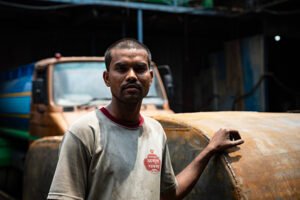
Truck artist Manish Kumar beside a hand-sanded tanker.
New Durga Kali Auto Workshop, Washing & Servicing Centre, Sanepa
The cost of painting trucks and tankers at Manish’s garage is around NPR 40-55,000/-. He works for 8-10 hours. Previously, Manish had to ask for photos, physically. Now, he downloads them from the Internet or WhatsApp. He enjoys his work and wants to improve his art to earn more. He shows his art to barbers who give him the contact numbers of prospective customers.
The common factors that bind the two truck painters are that despite the tough conditions and process, they are proud of their jobs and creations.
Painting
The truck artists make graphs for the designs. Then, they scale it up according to the size of the vehicle. Sometimes, they also paint freehand from scratch. The painting process involves removing rust by hand sanding, applying primer and putty, hand sanding again, cleaning the dust, applying surfacer, undercoating, colouring, covering blemishes and ultimately buffing carefully. The resilient deco paint lasts for a minimum 5-7 years, dries up quickly and has good colour retention capacity. However, the customers prefer the cheaper enamel paints that last 2-3 years. The painters are mindful of colour balance, aspect ratio and colour contrast. They follow the text provided by the customers. The figures are usually proportionate though the spellings, especially those of English words, may have errors.
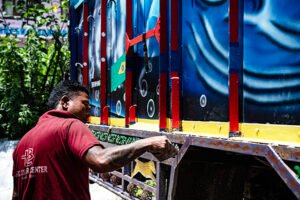
Truck artist hand sanding a truck
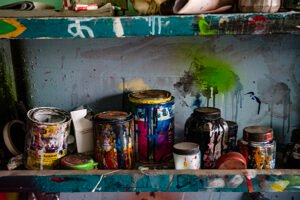
Paints used in truck art
Though the truck painters have mastered the art, they are not aware of the origin of truck art.
South Asian Truck Art
Transport vehicles have long been decorated in South Asia, especially in Pakistan and India, frequently in exaggerated designs and colours. Bangladesh has kitschy paintings on rickshaws. Sri Lankan tuk-tuk drivers hold annual competitions to show off their decorations.
Truck Art, known as Phool Patti in Hindi and Urdu, typically features regional patterns, themes, and calligraphy. Since these are mobile homes for the drivers, they mostly depict nostalgic and native elements. Apart from paintings and lettering, embellishments include mirror work, embossed metals, wood carvings, chains, pendants, crocheted hangings, etc. International carriers proudly display national flags and emblems.
Pakistani Jingle Trucks and Tattooed Nepali Trucks
Pakistani truck art caught international attention during the Afghanistan conflict in 2001-2002. The American soldiers named the boisterously decorated trucks as jingle trucks for the sounds made by the chains and pendants on the bumpers. These are fancifully ornamented like brides and are culturally relevant with images of popular figures, sayings, hearts, flora, and fauna in intricate arabesque. They display a variety of expressions, experiences, and beliefs. Sometimes, the riot of colours may cause distraction.
Contrarily, Nepali truck art tells more nuanced, concrete, and focused stories. The tattooed vehicles have one theme at the back and sometimes, may sport a different theme on the sides. The most popular images are that of Shiva, Ganesh, the Buddha, Bob Marley, Che Guevara, Jimmy Hendricks, and Nature. ‘Buddha was Born in Nepal’ is the most flaunted image and phrase on cross-border carriers.

The Nepali national flag with a sleeping Buddha on a tanker
Pakistani and Indian truck art have carved out a space beyond roads that Nepali truck art has not.
Potential of Nepali Truck Art
Fashion designers, including Dolce and Gabbana, have used the vibrant hues of Pakistani trucks and printed them on dresses, shoes, and luxury items. International art collectors recognise this art and buy pendants, side panels, ornate crown-like decorations, etc. To preserve and popularise truck art, graphic designers like Farid Bawa of India, sell prints of truck art online.
From the Art Curator’s perspective
Sangeeta Thapa, founder-director of the Siddhartha Art Gallery in Kathmandu
Sangeeta Thapa is struck by truck art and catchy couplets that are religious or humorous. She noticed truck art in Pakistan. The trucks are decorated with Mughal motifs, geometrical, and floral patterns in enamel paint. Thapa has bought panels from rickshaws in Bangladesh. She remembers Bangladeshi rickshaw painter Jamal visiting Nepal and localising his art by painting Pashupatinath or Hanuman on a cycle going to Pashupatinath.
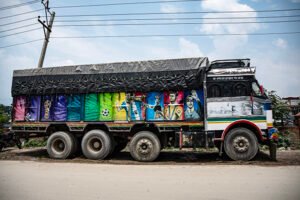
The FIFA World Cup, Messi and a truck
Thapa appreciates truck art and the precision needed to transpose small, printed images onto massive panels of trucks or cylindrical expanses of tankers. Some people find this genre to be kitschy. However, it is not garish from the owners’ perspectives. It reinstates their purpose in life. Nepali truck art and its self-taught artists have enough potential to be showcased to the art world. Uma Shankar Shah and Govinda Azad are two former signboard painters who joined art schools and are now internationally renowned artists.
Swosti Rajbhandari Kayastha, Lecturer of Museum Studies and Nepali Art History, Lumbini Buddhist University, and Curator at Nepal Art Council
Swosti Rajbhandari Kayastha has often noticed truck art and has taken photographs as some of the art is pleasing to the eye. The meaningful verses convey positive messages to her. Kayastha enjoys looking at them and does not find them kitschy. The style suits the trucks. Even though these are not trained artists, their passion and effort are evident in the preciseness and balance of the compositions. She feels they should be encouraged to continue with their art.
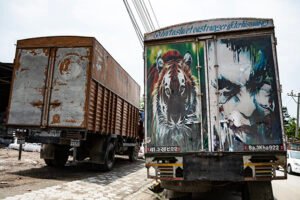
Trucks with and without art
Kayastha finds satisfaction in seeing the curvy Nepal Airlines livery painted on several buses and trucks. She was a judge of the open competition held to redesign the former livery, eight years ago. The winner created a wavy design, that was improvised upon the judges’ suggestions.
Keeping Nepali Truck Art Alive
Sangeeta and Swosti agree that the lively Nepali truck art and text are not distracting. The LCD hoardings are much more disturbing and may cause accidents. However, drivers need to be more disciplined and vigilant. The government should improve the roads and create congenial conditions for these artists to flourish and sustain their livelihood. You will, then, look forward to your next road trip.
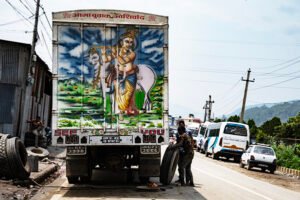
Deities reign supreme as subjects of truck art in Nepal
Maybe the next time you see “Buddha was born in Nepal’ or read ‘Has mat, Pagli, pyar ho jayega’*, you will feel proud or laugh out loud.
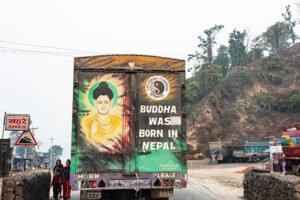
The most popular statement on trucks and tankers – Buddha was born in Nepal
*Laugh not, dear. I may just fall in love.

